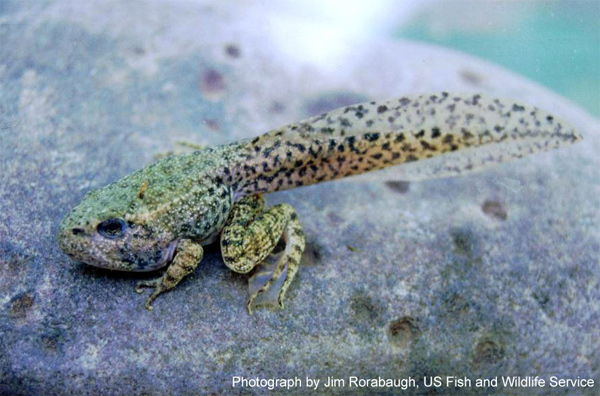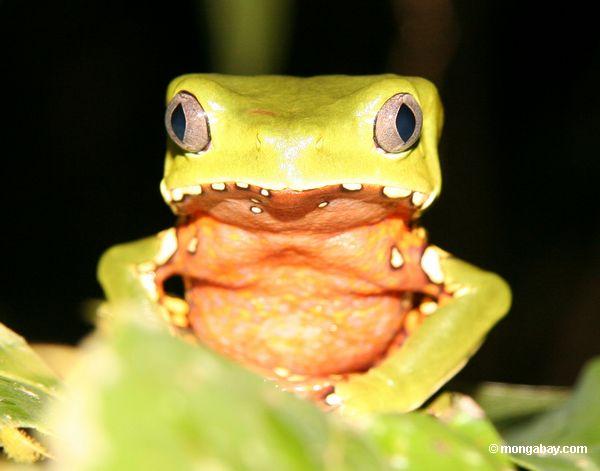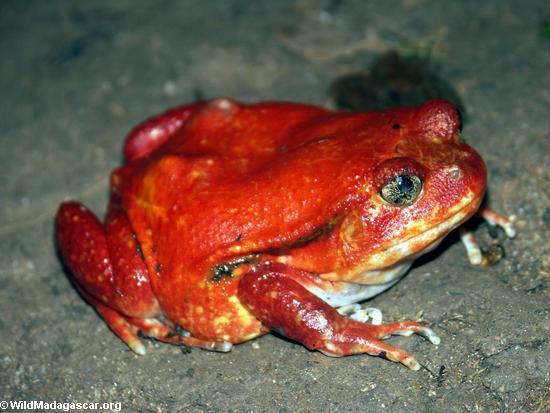|
|

|
|
The Adventures of Mongy the Bay Frog Chapter 2: In which we learn all about Mongy the Bay Frog's family By Christa Maas Mongy the Bay Frog and I were sitting at a stream in the rainforest. Well, to be exact, I was sitting with my feet inside the stream and Mongy was stuck to a leaf, hanging right over it. He does that a lot, so he can keep his body from drying out too much. I had noticed that Mongy was sad and I had waited for the right moment to ask him why. "What's wrong, my friend? You have been so very quiet today." Mongy looked down on me, sighed and said "Oh, nothing". But I don't give up that easily: "Come on, little guy , we have known each other for some time now and I know something is bothering you! Please, tell me what it is." Mongy the Bay Frog sighed another deep sigh and answered: "It's just that I don't remember." I was puzzled: "You don't remember what, Mongy?" "I don't remember where I came from and if I have a family. One day I opened my eyes and there I was. But I don't remember how." Now I let out a sigh as well, only my sigh was a sigh of relief. "My little green friend" I said, "let me tell you all I know about frogs and then maybe you will remember. First of all, you belong to a very large family called Amphibians. Amphibians are cold-blooded animals, which means they have the same temperature inside their bodies as they outside on their skin. Your family does not only include frogs, but you also have cousins like toads, salamanders, newts and caecilians. You don't drink water, you absorb it through your skin. You can breathe through your lungs and your skin and you are slimy, because secretions ooze out of your skin to keep you moist and protect you from infection. "I am not slimy!" protested Mongy. " Hrrrm; as I was saying, Mongy, your cousins, the toads are dryer and warty looking and they spend much more time on land than you do. Also, most frogs have teeth on the upper jaw but none on the lower jaw while toads have none. But you both lay eggs in the water." Mongy straightened up and listened intently, so I continued my explanation: "After mating, your mother laid eggs onto the inside of a leaf overhanging a stream or a pool of water, just like you are hanging there now, Mongy. Then, when the eggs matured, you fell into the water and started your larval stage". "What's a larval stage?" asked Mongy. "That's what we commonly call a tadpole. Look down into the water, and you will see them swimming. They have little oval bodies with the long tales. The larval stage lasts a few months and then you enter a short metamorphic period. It means that you change from a tadpole to a real frog. Frogs live for five or ten years, but some frogs can live more than thirty years". 
"Hmmm, does that mean, we frogs never know our mothers?" wondered Mongy. "No, Mongy, there are a few frog species that give birth to living young, too. Actually, there are a lot of really cool frogs in this world. Strawberry Poison Dart Frogs for example avoid laying their eggs in ponds and streams. They let the eggs develop on land and when the tadpoles hatch; their mother carries them on her back to the water-filled bromeliads in the trees. Bromeliads are plants that belong to the orchid family and they collect water between their leaves. Here the little tadpoles can grow up without having to worry about predators and their mother feeds tem with unfertilized eggs. "What's a predator, Christa?" "Well, every species on the planet has natural enemies. You have to watch out not to be eaten by your natural enemies, like fish, birds, turtles, snakes and land animals like foxes, bats, and birds. But you also have to watch out for humans. They don't understand that more than 75 % of all tad and frog species in the world live in tropical rainforests, and if they destroy the forest and pollute the water, frogs and other amphibians die. Environmentalists are trying very hard to save Amphibians. There are more than 6000 different species and already 2000 are in danger of being extinct, and still scientists discover new species every year!" Mongy looked at me with his big red eyes wide open "Oh, Christa that is soooo scary!" he said. "Yes Mongy, it is. But if people learn more about their environment, they start protecting it, so the best thing for us to do is to teach them. You know, frogs are very useful to humans, too. They eat a lot of insects, and some of these insects can be harmful to humans. And in the early 1990s, Abbott laboratory started working with poison arrow frogs. Poison arrow frogs are small, colorful frogs found in the tropical rain forests of Central and South America. They have really brilliant colors and their skin has a substance called "alkaloid" that is poisonous. In Columbia there is a golden poison frog called "Phyllobates terribillis" that can kill you if you hold him in your hand. But Abbot Laboratory discovered that the alkaloid can become a powerful painkiller, not poisonous and much safer than the one used now, which makes people addicted, sick and sleepy." With that, Mongy leaped up and started to hop around as if he were doing a real Indian dance and kept on chanting: "I am an Amphibian, tralala. I have a family, and my family is really, really cool tralala. I am a VIF, tralala. "Mongy, what's a VIF?" I asked him. "A VIF is a VERY IMPORANT FROG of course!" laughed Mongy. And you know what, kids? I think he is right! More super interesting stuff about frogs and amphibians:
Chapter 3: Mongy the Bay Frog's meets Ringo the orangutan |
 |
The Adventures of Mongy the Frog
|
|
|
|
worldrainforests.com/kids is published under a creative commons license.  
©2010 mongabay.com |


